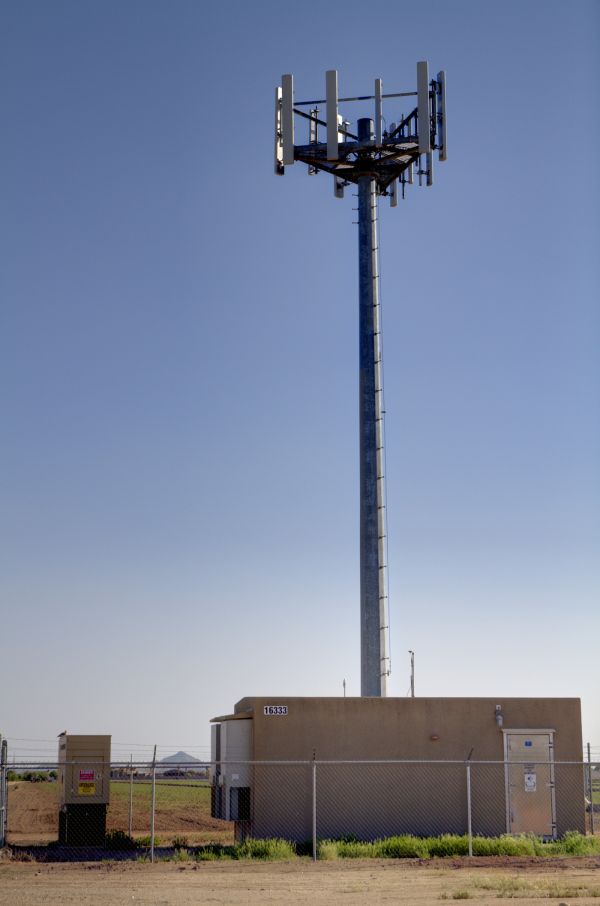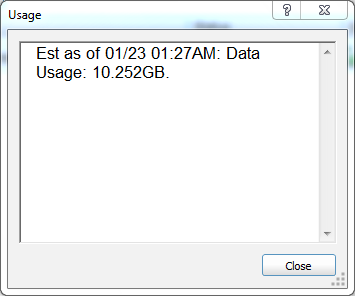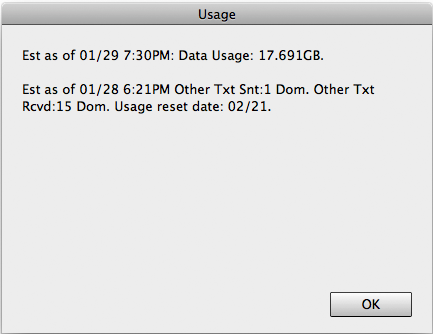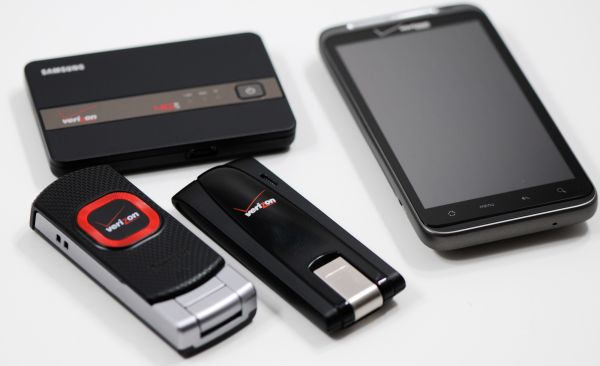Verizon 4G LTE: Two Datacards and a WiFi Hotspot Massively Reviewed
by Brian Klug on April 27, 2011 12:11 AM EST- Posted in
- Smartphones
- Samsung
- Verizon
- LTE
- 4G
- Pantech UML290
- USB551L
- Mobile
- MDM9600
Conclusion and Final Thoughts
We've been over a lot throughout the course of this review, but there's still so much more to be said about both LTE and the intricacies of Verizon's implementation. We're going to be doing a larger and more educational anthology piece later in the summer as well. Further, we'll no doubt give the same treatment to other carriers launching new LTE networks and faster HSPA+ ones.

A photo of a Verizon 4G LTE eNodeB in a field. Longer antennas on the tower are for 700MHz LTE.
The end result of all this testing over the course of literally months is that I'm insanely jealous of everyone in a market with 4G LTE already turned on. I've driven back and forth countless times, and each time I've grown a bit more spoiled with just how fast LTE is.
The performance picture is equally clear. Worst case speeds on LTE are about as slow as EVDO is fast, around 1.5-2Mbps. When you're in a good coverage area and have good SINR, the speeds are easily an order of magnitude faster, just as advertised. That's definitely a generational improvement, and things will only get faster once we get category four modems and higher 4x4 MIMO enabled with category 5. Again current implementations are category 3 and 2x2. The next round of things to look for will be second generation LTE modems which will bring both improved performance (MDM9625, category 4) and reduced power profile (MDM9615).
The other part of the picture is how Verizon's LTE deployment will stack up against other carriers' planned deployments. Verizon is in an extremely competitive position thanks to its nationwide upper C block license that grants it 22MHz of 700MHz spectrum everywhere in the US. In a number of markets, it also has lower A and B block licenses, giving it even more spectrum to deploy more channels when capacity starts picking up. That means Verizon has up to 34 or even 46MHz of 700MHz spectrum to play around with. AT&T on the other hand has a sprinkling of lower block B and C licenses that are both 12MHz. AT&T also purchased Qualcomm's licenses to blocks D and E, which are both 6MHz unpaired, though it's not entirely clear how AT&T will integrate both blocks of unpaired spectrum. All total that gives AT&T between 12 and 36MHz of 700MHz spectrum depending on market. That's really the moral of the story here—performance and coverage are going to vary greatly depending on what licenses each carrier has in your market.
The next part of the story are the launch devices themselves and pricing. 4G LTE data cards and hotspots on Verizon come with a data allowance of either 5 or 10GB, for $50 and $80 a month, respectively. Go over those data caps, and you'll be billed $10/GB. I found it shockingly easy to burn through massive amounts of data on every LTE card—I ate up 10GB testing the Pantech UML290 on a weekend, and then over 17GB later on. Don't even ask about the Samsung hotspot. I shudder when I think about the bills I would incur were these devices in my pocket all the time.
As of this writing, the HTC Thunderbolt gets you "unlimited" LTE data for $29.99/month, though a 5GB soft cap no doubt applies. It's also confusing to me that maximum allowed user caps are still applied to LTE WiFi hotspots, and even more puzzling is the fact that five is the number of users when the Thunderbolt allows eight, and the Droid Charge a rumored ten.
I guess that brings me to to the WiFi hotspot situation. Until the hotspots have 5GHz ISM band support for WiFi, I cannot do without hotspot-as-modem functionality. The situation at conferences is extreme, and continuing to deploy devices that set up reasonably powerful 2.4GHz WiFi APs for a few nearby devices only exacerbates the problem. Deploy all of this into the 5GHz band with its greater number of nonoverlapping channels and everyone will be able to breathe easier—for at least another couple of years until that too becomes saturated.
Both data cards function perfectly on Windows, but OS X stability needs major amounts of work. The irony of the situation is that the newer USB551L with OS X support marked on the box in my testing was considerably less stable than the older Pantech UML290. Firmware updates and an update coming to the VZAccess Manager software should fix these stability problems.
For that reason, probably the best way to get on LTE right now is either through the Thunderbolt or one of the LTE WiFi hotspots. The Samsung SCH-LC11 was consistently stable and clung to 4G LTE impressively well, where the data cards require an occasional disconnect and reconnect.
If you made it this far, I hope you gained something from this article. Looking at the evolution of the PC, high speed internet access went hand in hand with improvements in processing power. The smartphone industry has seen a tremendous amount of improvement in CPU and GPU power over the past three years and it looks like LTE will be sufficient to support that trend for the foreseeable future.













32 Comments
View All Comments
Brian Klug - Thursday, April 28, 2011 - link
I mentioned that with LTE sometimes the handovers pause the data context while the handover happens. It's an occasional 50-500ms pause, sometimes a second. Honestly I noticed it more on the data cards than I did the thunderbolt or the Samsung hotspot.That's another thing which will improve with time.
-Brian
iwod - Wednesday, April 27, 2011 - link
I dont think Bandwidth was much of a concern for mature 3G market. Even 1Mbps is good ( enough ) for web surfing. The problem is latency. And it is very high for 3G network,sometimes up to 1sec.LTE was suppose bring round trip performance down to double digit ms range. But my skip through of this article sees no test on Latency.
Another growing concern for me, is that Data and Mobile Network just dont seems to work. You have a finite amount of total bandwidth, but people consume data far greater then anyone would expect. I think someday we have to deploy national wide Micro WiFi + LTE station to help with bandwidth. Especially in populated city. ( I cant even imagine how would it even work out in place like Hong Kong and China )
Brian Klug - Thursday, April 28, 2011 - link
We tested latency on Page 10 if you're interested. Both latency as measured by speedtest.net (which isn't perfect) and by using pingplotter for almost 12 hours to a number of targets.It's sub 100 ms for a lot of things, and I showed gaming at 50ms to a local CS:S server. It's a definite improvement again thanks to much faster signaling and a shorter frame time.
-Brian
DanNeely - Thursday, April 28, 2011 - link
Unless I'm misunderstanding what the graph is showing, ATT's lower C block ownership is fragmentary with no coverage at all in large parts of the country.http://www.phonescoop.com/articles/article.php?a=1...
DanNeely - Thursday, April 28, 2011 - link
nevermind, I misunderstood what you were saying....bman212121 - Sunday, May 1, 2011 - link
I've seen another report from someone using LTE in New Orleans showing similar numbers. Anything sub 100ms should be fine for an fps. I've definitely seen worse under normal circumstances. FWIW using a D2 and comparing the ping times from the phones terminal to a pc using 3G hotspot, the wireless added 16ms latency.bman212121 - Sunday, May 1, 2011 - link
I have to wonder if they didn't include USB tethering simply because they couldn't sustain the power needed. If you were having issues with a 700ma charger than the maximum 500ma from a computer's usb port could be problematic. It is interesting though that the other devices worked, so I'm guessing that the wifi is what is really eating battery life.tjk818 - Wednesday, July 27, 2011 - link
I have the Pantech UML 290 and a cradlepoint router all updated with the latest firmware (4glte and 3g)works great on 3G now converting to 4g LTE using a ZADACOM feed cut for verizon746-806mhz and a grid antenna( Hyperlink ) . Without the grid I get 1 bar constant sometimes gong to 2 bars with the GRID I get nothing,Does the cable in the Pantech modem need to be connected or disconnected for it work on the grid , I live about 3 miles from the tower . also is there a setting that i can use in the VZAM menu ( under the DIAGVZW menu) that I can set the modem 4g port to activate the external antenna port and deactivate the internal antenna ? I’m using a specan I can see the carriers from the tower at 783mhz.
feed back is welcome
milan03 - Monday, August 22, 2011 - link
Hey Brian: you've mentioned that current Verizon LTE devices are category 3 meaning they can only achieve up to 50mbps with 2x10Mhz. Are you sure that's the breakdown because I'm seeing 50+mbps on a daily basis here in NYC and when downloading sustained well seeded torrent I'm seeing around 6MB/s which makes no sense. I am convinced that Thunderbolt is capable of 73mbps with all the overhead up to about 60mbps. Am I wrong? I dod have poor upload speeds which explains Thunderbolt being 2x1 MIMO not 2x2 like other devices, but is there any other LTE handset that's 2x2 MIMO?Here is what I'm seeing these days: [IMG]http://i51.tinypic.com/dhe1rd.png[/IMG]
oz973 - Tuesday, January 17, 2012 - link
How long does it take for this to charge to 100%? And how can you tell?